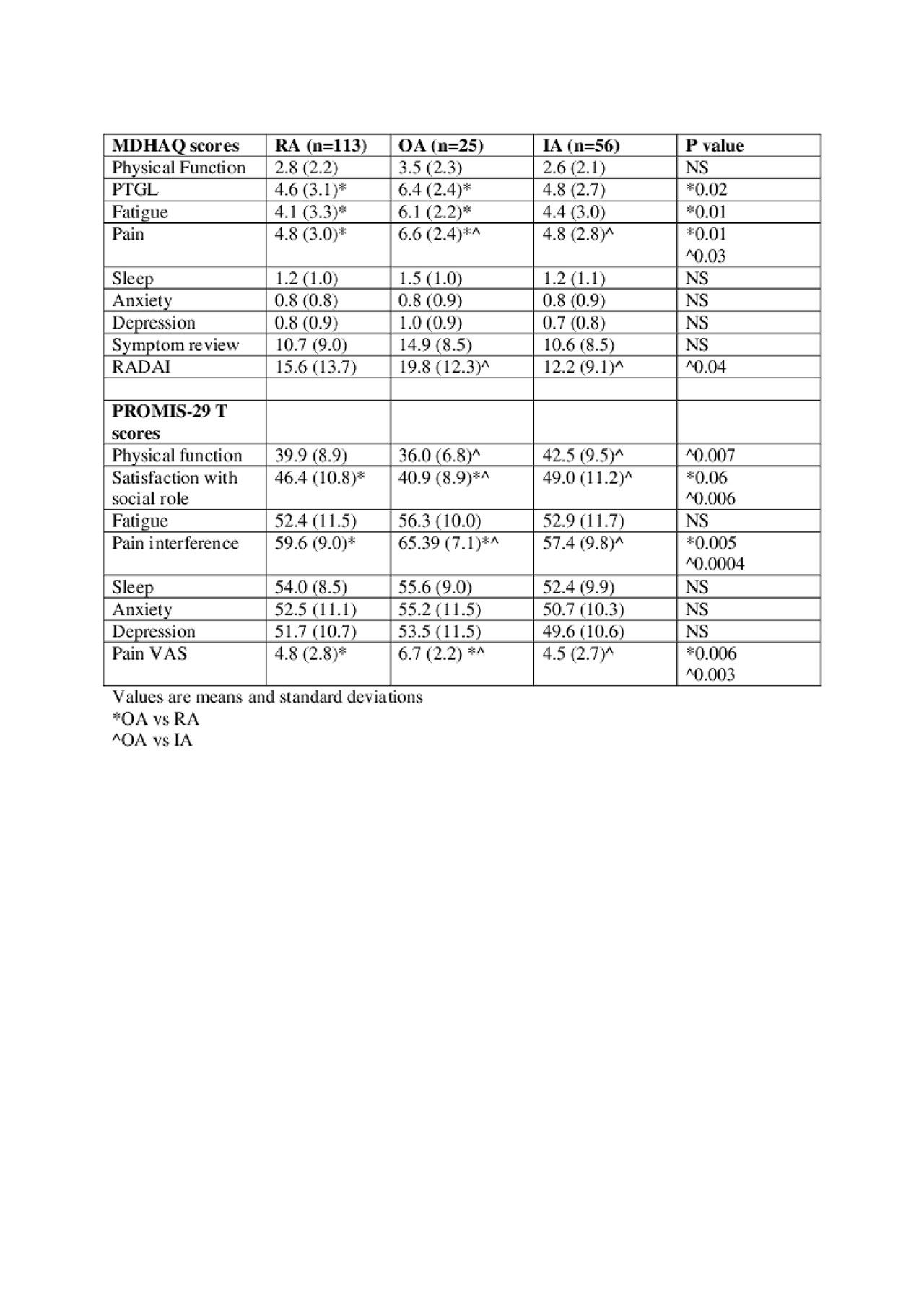Session Information
Session Type: Poster Session (Monday)
Session Time: 9:00AM-11:00AM
Background/Purpose: Guarded support for PROMIS-29 assessment in musculoskeletal disease has been reported in RA, OA, FM and SLE patients1. The performance of PROMIS-29 compared to legacy measures in Australian patients with RA, OA and other inflammatory arthritic conditions (IA) has not been examined. The aim of this study was to determine similarities and differences to performance of the multidimensional health assessment questionnaire (MDHAQ).
Methods: All consented patients complete a MDHAQ and the static 29 item PROMIS profile (PROMIS-29) questionnaire prior to seeing their rheumatologist. A cross sectional sample of 113 RA, 25 OA and 58 patients with IA (ankylosing spondylitis, psoriatic arthritis and inflammatory arthritis) was analysed. PROMIS-29 assesses 7 domains: physical function, anxiety, depression, fatigue, sleep disturbance, satisfaction with participation in social roles, pain interference and a 0-10 pain intensity scale. Scores are standardised against US normative population data producing T scores with a mean of 50 and a standard deviation of 10. The MDHAQ assesses physical function (0-10), sleep disturbance, anxiety and depression (0-3.3), pain (0-10 VAS), patient global assessment (PTGL) (0-10 VAS), self-report joint count (RADAI) (0-48), 60 question symptom review and fatigue (0-10 VAS). Means and standard deviations (SD) of PROMIS T scores and MDHAQ variables and percentage of patients achieving minimum and maximum values for each variable were calculated. ANOVA compared PROMIS-29 T scores and MDHAQ means across disease groups. Floor effect is defined as the ‘best’ possible score and ceiling as the ‘worst’ possible score, irrespective of the direction of the scale. A substantial floor or ceiling effect is defined as ≥15% with either score.
Results: Patients were predominantly female with a mean age of 57.4 +/-14.4 years and mean disease duration >14 years. OA and RA patients were significantly older than IA patients (p< 0.04). MDHAQ scores for PTGL, fatigue and pain were significantly higher in OA than RA (p≤0.04) (Table 1). Pain and RADAI were also higher in OA than in IA (p≤0.04). The PROMIS-29 mean T scores for physical function, satisfaction with social role, pain interference and mean Pain VAS were significantly worse in the OA patients than the IA patients (p≤0.007). Satisfaction with social role and pain interference were also significantly worse in the OA than the RA group (p≤0.06). No significant differences between RA and IA were seen by any MDHAQ or PROMIS-29 measure. Significant floor effects were found for MDHAQ and PROMIS-29 depression and anxiety in all groups. MDHAQ sleep disturbance, also demonstrated significant floor effects across all groups. A ceiling effect was only seen in OA pain interference.
Conclusion: PROMIS-29 and MDAHQ scores performed similarly across a range of comparable domains but differed for physical function and fatigue assessment. Significant floor effects were found for both instruments. Each provides data for constructs not available in the other, which should be considered when choosing a tool to inform clinical care.
1. Katz P et al. (2017) Arthritis Care & Research 69(9):1312-1321

Table 1 Participating subject MDHAQ and PROMIS
To cite this abstract in AMA style:
Hassett G, Gerogevsky D, Descallar J, Fang R, Huang F, Gibson K. Performance of the Patient-Reported Outcomes Measurement Information System 29 (PROMIS-29) Item Profile in a Cohort of Australians with RA, OA and Other Inflammatory Arthritic Conditions [abstract]. Arthritis Rheumatol. 2019; 71 (suppl 10). https://acrabstracts.org/abstract/performance-of-the-patient-reported-outcomes-measurement-information-system-29-promis-29-item-profile-in-a-cohort-of-australians-with-ra-oa-and-other-inflammatory-arthritic-conditions/. Accessed .« Back to 2019 ACR/ARP Annual Meeting
ACR Meeting Abstracts - https://acrabstracts.org/abstract/performance-of-the-patient-reported-outcomes-measurement-information-system-29-promis-29-item-profile-in-a-cohort-of-australians-with-ra-oa-and-other-inflammatory-arthritic-conditions/
